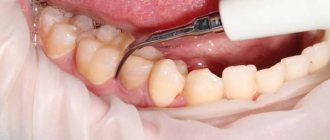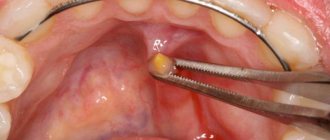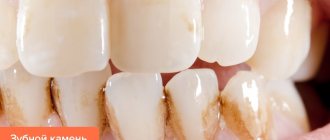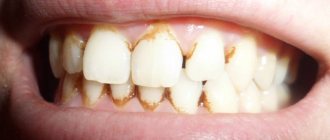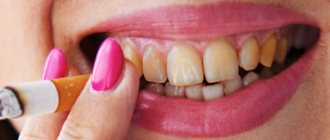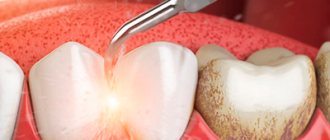From this article you will learn:
- how to remove tartar with ultrasound,
- pros and cons of the technique,
- cleaning teeth from tartar – price 2021.
The article was written by a dentist with more than 19 years of experience.
Ultrasound removal of tartar is the most effective method of professional oral hygiene. Its advantage is that it allows you to clean your teeth from any type of dental plaque -
1) supragingival calculus, 2) subgingival calculus, 3) black pigmented plaque, 4) partially mineralized soft microbial plaque.
But, unfortunately, ultrasonic teeth cleaning does not always have positive reviews. This is usually due to the fact that doctors remove only supragingival stones, leaving subgingival deposits, which leads to the gradual destruction of the bone around the teeth and the appearance of their mobility. But the quality of dental plaque removal depends not only on this, and in this article we will analyze in detail all the features of this method.
Ultrasonic teeth cleaning from stone – price 2021
If you need to remove tartar, the price will be about 100 rubles per 1 tooth (this price includes ultrasonic cleaning and polishing, but does not include fluoridation). The calculation can be made not only based on the number of teeth that need to be cleaned, but also at an all-inclusive rate.
Ultrasound removal of tartar - prices for the all-inclusive tariff (ultrasound removal of tartar + AirFlow polishing + fluoridation) will be: in the regions about 2500–3000 rubles, and in the blades of the economy segment of Moscow - the price for the all-inclusive starts on average from 4300 rubles.
Why does plaque and tartar form?
The condition of the oral cavity, gums and teeth is directly related to how we take care of their cleanliness and how accurately we follow the doctor’s recommendations regarding hygiene. Do you think brushing your teeth three times a day is the key to oral health? Unfortunately, it's not that simple!
Even the most thorough brushing with a toothbrush cannot remove food particles from hard-to-reach places in the mouth.
But the fact that these particles remain leads to the formation of plaque, and then stone, which gradually destroys the enamel. The reasons for plaque formation can be different:
- poor oral hygiene;
- incorrect choice of hygiene products;
- improper tooth brushing mechanism;
- metabolic disorders in the body;
- errors in preparing the diet (lack of solid food).
Dental plaque usually forms on the inside of the dentition, accumulating at the base of the teeth, and causes inflammation and bleeding of the gums, the development of periodontitis and gingivitis.
Important
: Tartar can be removed from teeth only by professional methods using special equipment; it is impossible to do this on your own; traditional methods are more likely to harm than help.
The recommended frequency of cleaning teeth from hard deposits is twice a year.
Removal at home
It is impossible to remove hardened tartar at home. The only thing you can do is try to remove soft dental plaque. To do this, use special rotating toothbrushes and abrasive toothpastes. You can use such compositions no more than twice a week so as not to damage the enamel.
The use of folk remedies gives a dubious effect, but, if desired, you can try and see for yourself.
- Radish and lemon juice. Grate the radish, add natural lemon juice. Wet the brush and rub your teeth. (The main component of this “elixir” is acids that destroy enamel).
- Eggplant ash. The vegetable should be burned over an open fire, and the most problematic areas should be rubbed with ashes every day. The expected result can be observed after a week and a half.
- Horsetail decoction (for 200 grams of water - 30 grams of dry herb). Boil for half an hour. Rinse your mouth morning and evening with 1/3 cup.
Important. Among the “folk” recipes found online, there is an infusion of celandine, the use of which poses a health hazard.
Modern methods of removing tartar
The method of removing tartar involves the step-by-step implementation of the following procedures:
- Actually cleaning teeth from plaque and tartar.
- Polishing the surface of the teeth.
- Saturation of enamel with fluoride (fluoridation).
The dental clinic will offer you several ways to remove tartar, namely:
- Chemical is a not very popular method based on the use of chemicals (usually aggressive compounds) that can soften tartar.
- Manual - involves performing the procedure manually, is characterized by high thoroughness and delicacy, allows you to efficiently clean the teeth at the very base; The technique is usually used as an additional method in combination with hardware cleaning.
- Laser is a painless process that has proven itself in practice, the essence of which is the destruction of the integrity of hard deposits with a directed laser beam, followed by the removal of destroyed particles from the surface of the tooth. Despite all the positive aspects, the method has a number of contraindications, including increased tooth sensitivity, the presence of extended teeth or dentures, and a large number of dental fillings.
- Ultrasound is the most effective method to date, which we will dwell on in more detail.
To remove minor deposits, the Air Flow method is successfully used, which involves the use of a special mechanism for supplying air and a soda solution (sodium bicarbonate + water) under pressure.
The method is characterized by painlessness and atraumaticity, is ideal for removing coloring pigments from teeth, provides simultaneous polishing of the tooth surface, and after cleaning the teeth acquire a special shine.
The technology is suitable for hardened smokers.
However, there is a contraindication to the method - bronchial asthma. The Air Flow system cannot cope with tartar.
How to remove tartar in dentistry
Tartar is removed in a dental clinic using modern techniques that allow the stone to be completely destroyed. The earlier deposits are detected, the easier it is to remove them.
The procedure takes about an hour in total. First, the doctor removes the supragingival stone, and, if necessary, the subgingival stone. Then the teeth are polished and a fluoride toothpaste is applied.
In their work, dentists usually combine several methods of stone removal. This approach allows you to get the most effective results. Once the problem is eliminated, the risk of complications is significantly reduced.
Ultrasonic teeth cleaning is the best modern solution
The ultrasonic method of removing tartar combines high productivity and special advantages, such as:
- No aggressive or harmful chemical effects on enamel;
- Minimal trauma, can be used even with fragile tooth enamel;
- The ability to effectively act on deposits of any nature, removing plaque even in hard-to-reach places;
- The presence of an antiseptic effect (elimination of harmful microorganisms);
- Efficiency and painlessness of the procedure;
- Affordable price.
Prevention
To prevent diseases and dental plaque, it is necessary to brush your teeth using the correct method, use suitable hygiene products, have professional cleaning done by a specialist twice a year, and treat dental pathologies. It is recommended to use mouthwash, chewing sugar-free gum after meals, and dental floss and irrigator before bed. It is also necessary to treat chronic diseases of the body, avoid bad habits, and increase the body’s immunity.
Why you should turn to professionals
It is impossible to completely remove hard plaque and stone at home. The formations are localized in hard-to-reach places and may be invisible to the naked eye. Only a dentist can perform high-quality and safe cleaning. The procedure is simple, affordable, very effective, and therefore recommended for children and adults of any age. If left untreated, dental plaque can cause various pathological consequences:
- Carious lesions;
- Exposure of necks and roots, tooth sensitivity;
- Aesthetic defects;
- Unpleasant odor from the mouth;
- Diseases of periodontal tissues (gingivitis, periodontitis);
- Diseases of the digestive tract;
- Decreased immunity;
- Risk of exacerbation of body diseases.
Read more about the possibilities of ultrasonic cleaning
Let's continue the conversation about ultrasonic teeth cleaning - the most effective modern method of removing dental plaque, almost completely safe and capable of cleaning teeth from:
- plaque, including pigmentation;
- stone at the base of the tooth, above and below the gum.
The procedure is performed using an ultrasonic scaler, through which water is supplied through a vibrating metal nozzle: high-frequency vibration destroys deposits on both sides of the tooth, and the water flow washes out these particles. There simply cannot be any hard-to-reach places for an ultrasound scaler.
The effect is complemented by an antibacterial effect. The procedure is indicated for use with a regularity of once a year.
A competent dentist will definitely prescribe teeth cleaning before treatment; before dental operations, the procedure is absolutely necessary.
This treatment will reliably protect against infection by removing bacteria and germs from the oral cavity. Ultrasound cleaning will also help when choosing the color of fillings and implants.
The importance of the procedure during implantation is determined by the following points:
- deep cleaning of periodontal pockets, including hard-to-reach ones;
- disinfection of dental sinuses and canals;
- teeth whitening on both sides;
- prevention of caries and gingivitis.
Types of pathology
There are the following three main types of dental plaque:
- Soft plaque is a deposit on the surface of the enamel in the cervical area, has a light or yellow color. Mainly consists of food debris and microbes. Soft plaque is easily removed;
- Hard plaque is a deposit of yellow, brown, black color, which is localized mainly on the inner surface of the lower teeth. Mineralized food residues, salt deposits, microbes.
- Tartar is a hard plaque that has grown significantly in size over time. The formation is localized mainly in the cervical areas of the teeth, especially on the inner surface of the lower front teeth and upper lateral teeth. The stone can be located under and above the gum, filling interdental cracks and spaces. The formation puts pressure on the gums, causes inflammation of periodontal tissues, and a carious process.
Ultrasound cleaning procedure
The process is not accompanied by pain and does not cause serious discomfort to the client. Includes several stages:
- Treatment of the dentition with a special solution (jet)
- Application of a special gel to soften hard deposits
- Ultrasonic cleaning
- Fluoridation
- Polishing
The total time for the entire procedure is up to 1.5 hours.
Why is fluoridation needed?
Cleaning the dentition from tartar may be accompanied by exposure of the dentinal tubules, and this, in turn, leads to increased tooth sensitivity. To prevent increased sensitivity, fluoridation is carried out - treating the enamel with a gel with an enamel-sealing substance based on copper hydroxide (applied using a tampon).
Techniques used:
- Simple fluoridation - placing a mold with a special solution on the jaw
- Deep fluoridation - applying F-containing varnish separately to each tooth
To achieve a lasting result, it is recommended to repeat the procedure three times at intervals of 1-2 weeks.
To prevent caries, it is recommended to take a course of 10-14 procedures.
When should you not brush your teeth with ultrasound?
Despite the atraumatic and highly safe method, ultrasonic cleaning has its contraindications. You will have to choose another method in the following cases:
- with increased tooth sensitivity;
- in the presence of complex orthopedic structures, including braces;
- in the presence of implants;
- patients with tuberculosis and autoimmune diseases;
- during the period of change of bite in children.
It is not recommended to carry out this procedure in the first trimester of pregnancy, with respiratory diseases, or in a state of acute cold.
Ultrasound cleaning and pregnancy: what's the problem?
Although dental care is especially important during pregnancy, ultrasonic cleaning in the early stages of gestation is strongly not recommended due to the fact that ultrasonic waves, imperceptible to us, can disturb the fetus, causing it discomfort.
In addition, in conditions of unstable hormonal levels characteristic of pregnancy, the procedure can cause swelling and bleeding of the gums
Specialists may refuse ultrasound cleaning to a pregnant woman even at later stages if she has:
- Pacemaker
- Dentures
- A number of diseases (ARVI, diabetes mellitus, epilepsy, bronchitis, asthma, sexually transmitted diseases or cancer)
To avoid unforeseen complications, pregnant women should postpone non-urgent procedures until hormonal levels stabilize; As a rule, the risks of dental manipulation are minimized after the second trimester of pregnancy.
Probability and causes of complications
Like any other dental intervention, ultrasonic cleaning can lead to undesirable consequences. Complications may be associated with:
- increased sensitivity of the gums (irritation or bleeding);
- mechanical thinning of tooth enamel as a result of previous procedures using aggressive polishing pastes;
- using an outdated installation (previously less gentle attachments were used);
- low qualification of the dentist.
Possible complications
Plaque is the #1 cause of gum inflammation (gingivitis and periodontitis). Therefore, in the long term, this problem can even lead to tooth loss. In addition, deposits are localized on the teeth, and the bacteria that make them up lead to the destruction of enamel, the appearance of caries and other dental diseases.
The aesthetics of a smile are also disturbed, an unpleasant and even putrid odor from the mouth occurs, which affects a person’s psychological comfort. Another consequence is disruption of the digestive tract, since plaque is bacteria and, along with food, they also enter the stomach.
Air Flow technology: softer than ultrasound
The technology involves cleaning the dentition (soft and hard deposits) using a water-air jet based on baking soda (sodium bicarbonate). The combination of properties such as the solubility and abrasiveness of sodium bicarbonate makes cleaning very effective, and flavoring agents are added to the mixture to minimize patient discomfort.
The Air Flow method is particularly gentle on the enamel and has a visible result. The cleaning process involves exposing the teeth to a jet under strong pressure at an angle of 30°, during which plaque (not stone) is softened and removed! The dentist’s task is not to touch open areas of dentin and gums during the procedure.
After cleaning using the Air Flow method, smoking and eating/alcohol consumption is prohibited (from 3 to 6 hours).
Air Flow technology is indicated for use in the following cases:
- for cleaning implants, metal-free ceramic structures, ceramic veneers;
- before filling or implantation, during dental restoration;
- if necessary, mineralize tooth enamel (fluoridation);
- for cleaning the bracket system.
Cleaning using this technology involves removing a protective organic film, which temporarily makes the teeth very sensitive. Therefore, it is recommended to use mouth rinses and replace your toothbrush.
Subsequent processing: fluoridation + polishing
A mandatory step after brushing (except for Air-Flow) is teeth polishing. After the procedure, the enamel becomes slightly rough, as microscopic particles of stone and mechanical irregularities remain on it. If the surface of the teeth is not polished, plaque will settle much more intensely than before brushing.
For polishing, use special brushes or a water-air jet with an abrasive mixture.
To reduce tooth sensitivity after the procedure and strengthen the enamel, special compounds with a high content of sodium fluoride are applied to the surface of the teeth. The procedure is not mandatory, but its implementation will help to quickly restore damaged layers.
Stone removal with 20% discount
Moscow
Prevention of tartar formation
Whatever technology is used, the procedure for removing tartar is quite expensive, so after cleaning the patient usually comes to understand how important it is to take care of reducing the rate of appearance of new deposits
As a preventative measure, dentists recommend using special pastes that contain abrasive substances (for example, calcium carbonate) and tensides that prevent the creation of tension on the surface of the tooth and, as a result, the deposition of plaque.
Such pastes prevent the appearance of plaque and darkening and are effective in preventing the development of gingivitis, but with prolonged use they lead to thinning of the enamel.
Ultrasound removal of dental plaque: technique
If you only have supragingival deposits and/or pigment plaque on your teeth, then the cleaning procedure usually only takes about 1 hour. With this type of deposits, ultrasonic cleaning can be carried out even by a regular dentist.
Important: but if you suffer from periodontitis (inflammation of the gums), then cleaning is best done by a periodontist. This will give a greater guarantee that you will then have subgingival dental plaque removed, and also, if necessary, prescribed a course of home anti-inflammatory therapy, which will include rinsing the mouth with antiseptics and applying gels to the gums.
Removing dental plaque with ultrasound consists not only of an ultrasonic cleaning procedure, but also the mandatory subsequent polishing of teeth, and ideally, also fluoridation. Below, we will talk in detail about the intricacies of each stage.
How much does professional teeth cleaning cost?
The price of the procedure is determined by the chosen technology, the number of dental units being cleaned, and depends on the prestige and pricing policy of a particular dental clinic.
Approximate prices:
- Ultrasonic cleaning - from 100 rubles. for a unit;
- laser cleaning or Air Flow technique (per procedure) - about 3 thousand rubles;
Be sure to also remind your doctor about fluoridation and polishing, which are often paid separately.

